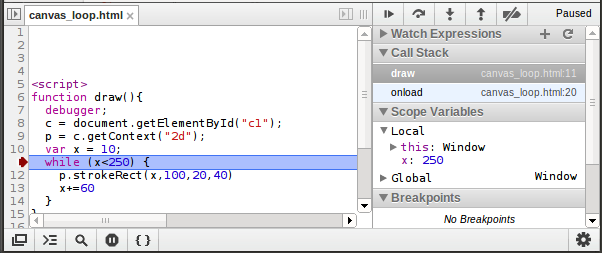Looping with canvas: Difference between revisions
No edit summary |
No edit summary |
||
| (5 intermediate revisions by the same user not shown) | |||
| Line 11: | Line 11: | ||
The condition should be some kind of "boolean" expression that is "true" for a while, and eventually "false" when the loop should stop running. | The condition should be some kind of "boolean" expression that is "true" for a while, and eventually "false" when the loop should stop running. | ||
<canvas id="c1" showsrc> | |||
<canvas id="c1"> | |||
function draw(){ | function draw(){ | ||
c = document.getElementById("c1") | c = document.getElementById("c1") | ||
| Line 26: | Line 24: | ||
</canvas> | </canvas> | ||
Variation: When the loop reaches the | Variation: When the loop reaches the edge it breaks the line. | ||
It redefines the "x" value to the | It redefines the "x" value to the beginning of the line and adds 40px to "y". | ||
<canvas id="c2" width="300" height="300" showsrc> | <canvas id="c2" width="300" height="300" showsrc> | ||
| Line 43: | Line 41: | ||
if (x > 600) { | if (x > 600) { | ||
x = 20; | x = 20; | ||
y = y + | y = y + 20; | ||
} | } | ||
} | } | ||
} | } | ||
</canvas> | </canvas> | ||
== Tracing the loop == | |||
Firefox and Chrome have a built in debugger that lets you watch how the loop happens... | |||
You can add a line that says "debugger;" to you code, then in Chrome, open Developer Tools and select debugger, then reload the page. | |||
Use the "step" button (on the right), or the F10 key to walk "step" by step through the loop, watching each rectangle be drawn, and the value of x changing until the condition (x < 250) is no longer true and the loop "breaks". | |||
[[File:CanvasLoopDebugger.png]] | |||
Latest revision as of 11:06, 1 October 2012
See also Canvas.
A basic coding control structure is the loop which takes it's simplest form as:
while CONDITION {
LOOP
LOOP
LOOP...
}
The condition should be some kind of "boolean" expression that is "true" for a while, and eventually "false" when the loop should stop running.
<canvas id="c1" showsrc> function draw(){
c = document.getElementById("c1")
//console.log("c is",c)
p = c.getContext("2d")
x = 10
while (x<250) {
p.strokeRect(x,100,20,40)
x+=60
}
} </canvas>
Variation: When the loop reaches the edge it breaks the line. It redefines the "x" value to the beginning of the line and adds 40px to "y".
<canvas id="c2" width="300" height="300" showsrc> function draw() {
c = document.getElementById("c2");
p = c.getContext("2d");
hands = 1;
x = 20;
y = 20;
while (hands < 100) {
//console.log(hands);
p.strokeRect(x,y,20,20);
x = x + 50;
hands++;
if (x > 600) {
x = 20;
y = y + 20;
}
}
} </canvas>
Tracing the loop
Firefox and Chrome have a built in debugger that lets you watch how the loop happens... You can add a line that says "debugger;" to you code, then in Chrome, open Developer Tools and select debugger, then reload the page. Use the "step" button (on the right), or the F10 key to walk "step" by step through the loop, watching each rectangle be drawn, and the value of x changing until the condition (x < 250) is no longer true and the loop "breaks".

